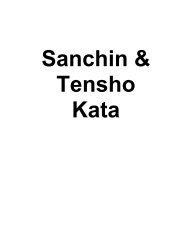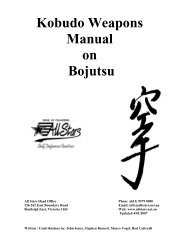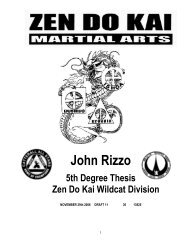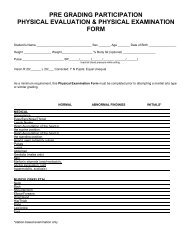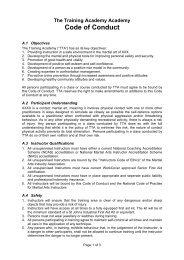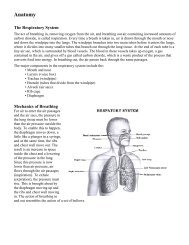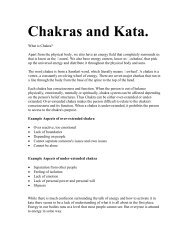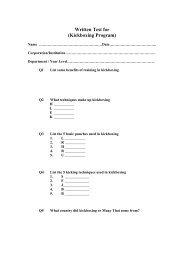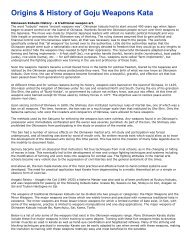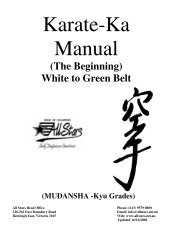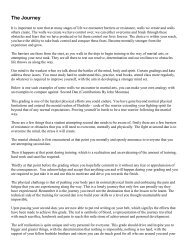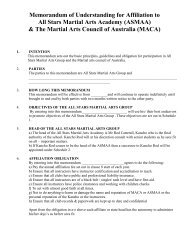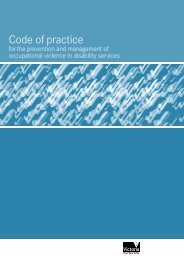Nunchuku weapons_manual.pdf - All Stars Self Defence Centres
Nunchuku weapons_manual.pdf - All Stars Self Defence Centres
Nunchuku weapons_manual.pdf - All Stars Self Defence Centres
You also want an ePaper? Increase the reach of your titles
YUMPU automatically turns print PDFs into web optimized ePapers that Google loves.
Origins of Martial Arts WeaponsOkinawan Kobu-do - A traditional weapon art.The word "kobudo" means "ancient <strong>weapons</strong> way". Okinawan kobudo had its start around 400 yearsago when Japan began to assert control over the Island of Okinawa. Warlords forced the Okinawanpeople to turn over their <strong>weapons</strong> to the Japanese. The move was made by Imperial Japanese leaderswith almost no realistic political foresight and very little insight or perception into the Okinawan wayof thinking. The ruling classes assumed that to gain political and financial control over this tenaciousisland race, all that was necessary was to disarm the people. The warlords specifically ordered that "all<strong>weapons</strong>" be turned over to the authorities. Little did the authorities realize that the Okinawan peoplewere such a nationalistic race and so strongly devoted to freedom that they would go to any lengths todeceive and/or hide the <strong>weapons</strong> they needed to fight their oppressors. The resourceful Okinawansadapted everyday farming and fishing implements -- 6-foot staff (bo), rice-grinder handle (tonfa),horse's bridle (nunchiyaku), boat paddle (ueku), rice sickle (kama), etc. -- for self-defensive purposes.Thus, <strong>weapons</strong> were called "farm implements", but underground the fighting population was trainingin the use and proficiency of these tools. Soon the <strong>weapons</strong> masters became a most feared force in thebattle for political freedom, feared by the Japanese and idolized by the Okinawan people whoseprotectorate they were. This was the birth of what we now know as Okinawan Kobudo. Over time, theuse of these <strong>weapons</strong> became formalized into a beautiful, graceful, and effective art that has beenpassed down from generation to generation.The <strong>weapons</strong> of traditional Okinawan Kobudo can be divided into two groups or categories: the MajorWeapons and the Minor Weapons. The major <strong>weapons</strong> are those which are widely known andpracticed with numerous traditional kata in existence. The minor <strong>weapons</strong> are those lesser-known<strong>weapons</strong> for which a limited number of kata exist. In fact, with some of the <strong>weapons</strong>, practice islimited to <strong>weapons</strong> manipulations and one-step applications. The major <strong>weapons</strong> of Okinawan Kobudoinclude: Bo, <strong>Nunchuku</strong>, Tonfa, Sai, Kama.At different times and for various reasons during its history, <strong>weapons</strong> were banned on the island ofOkinawa. In 1429, Sho Hassi united the kingdom of Okinawa under his rule and renamed North andSouth. During the era of his grandson Sho Shin, the policy of "Bunji-Kokka", or government byculture not military force, was put into effect. At this time all <strong>weapons</strong> were banned except for thoseused by military forces. The objective was to restore peace and to disarm rival clans.Upon seizing control of Okinawa, the Shimazu clan instituted numerous rules of martial law, one ofwhich was a ban on all <strong>weapons</strong>. This time, however, the ban was on a much larger scale than thatinstituted by Sho-Shin. Only the Satsuma samurai, who were the invaders and conquerors of Okinawa,were allowed to have <strong>weapons</strong>.- Page 5 of 20 -
The methods used by the Satsuma for enforcing the <strong>weapons</strong> ban were ruthless. Any <strong>weapons</strong> found inan Okinawan's possession were immediately confiscated and the owner was severely punished. As partof the ban, the Shimazu also prohibited the Okinawans from participating in the study or practice ofthe martial arts.This ban had a number of serious effects on the Okinawan martial arts. <strong>All</strong> study and participation wasforced underground, and all teaching was done by word of mouth only. No written records exist whichwould allow us to trace the development of the Okinawan arts during this time period. This has led tothe creation of many false legends due to the inability to document facts.Secrecy became such an obsession that instructors hid true techniques from rival schools, as in thechanging or hiding of moves in kata. This eventually led to the development of new and uniquefighting techniques and systems including the modification of farming and work tools into <strong>weapons</strong>for combat use. The fighting attitudes in the martial arts schools became very violent due to thesuppression of civil liberties and the general sentiment of the times.And above all, the ban made Karate one of the most practical and effective hand-to-hand combatsystems ever developed. The need for practical application kept Karate from degenerating to a mostlytheoretical art or a simple or obscure form of exercise.Stances in Kobu-doIn karate, stancing is designed to provide control of center line. In <strong>weapons</strong>, the concept stays thesame, but the execution changes depending upon the length of the weapon. If your underlyingmovement concept is based upon the use of natural, relaxed body positioning - then the stancing usedwith ones <strong>weapons</strong> will need to adjust depending upon the length (range) of the weapon being used.In practice short range <strong>weapons</strong> such as the tekkos or techu will employ stancing close to that used inones open hand movements. As the weapon range increases to the mid-range <strong>weapons</strong> (such as tunfa,sai, kama, nunchaku) and out to long-range <strong>weapons</strong> (bo, nunte bo, naganata) the width of the stancereduces in order to permit the natural position of the end of the weapon to be able to control thecenter line. In this manner one can learn to maximize their power of execution while minimizing theamount of power exerted to accomplish the movement. Also when playing with <strong>weapons</strong> theassociated concepts of minimizing ones target and being able to employ angular attacks, goes hand inhand with the use of relaxed natural movement in ones stancing and method of movement.As an interesting observation to having taught and observed numerous practitioners from variouskarate styles work kobudo over the years, I have found that the longer they are training (in a naturalrelaxed lineage focus), the more that they become similar in their movement - even though they mayhave started out from different karate movement perspectives.- Page 6 of 20 -
Masters of Kobu-doSources of information on kobo-do are scarce. Kobu-do dojo able to teach the original material is rare.This has forced much of todays teachers in creating kata and techniques because records of the art`sdevelopment are virtually non-existent. Having this lack of kobu-do material much of the art waspractised and developed in absolute secrecy, in the night time darkness of secret mountain retreats orsealed of in other similar places, safe from the intrusive eyes of any unwelcome people. To helpunderstand the lack of kobu-do information, the few masters of bo-jitsu (the art of using the bo ) are asfollows :Shinken TairaShinken Taira was born in 1890 (the 33 rd year of Meiji) in Kumijima City on the island of Okinawa.In 1923, he began studying karate under Master Gichin Funakoshi, founder of the art, and later,received intensive Okinawan kobu-do instruction from Master Mouden Yahishisa. After many years ofrigorous training, he earned his Master`s Degree and moved to Ikaho City in Gunma region, Japan.There he opened his first of many dojos and taught both karate and kobu-do. In 1940 (the 15 th year ofShowa), he returned to Okinawa and, in Naha, he established a dojo devoted purely to the art of kobudo.Although Master Taira passed away in 1970, the art lives on and flourishes through his students.One of them, Fumio Demura, has become over the years a leading exponent of kobu-do.SueyoshiWhile it is known that Master Sueyoshi was born sometime during the early 1900s, with oneexception no other details of his life have been recorded. This one exception is his kata for the bo,Sueyoshi-No KonToyamaBorn in the early 1900s, Master Toyama founded the style of bo-jitsu called Toyama-Ryu-Bo-Jitsuand his kata, Toyama-No-Kon remains for modern students to practice.Chinen of Yamane-RyuBorn in the early 1900s, Master Chinen`s extensive studies of bo-jitsu made him a specialist in theart. He developed many kata for the bo, among them Shuushi-No-Kon, Shirotaru-No-Kon (known inOkinawa as Ogusuku) and Yonegawa-No-Kon (Gyaku-Bo). Several of his students later becamefamous karateka renowned for their skill in kobu-do.Aragaki SeishoMaster Aaragaki, also born in the early 1900s, founded the Aragaki-Ryu style of kobu-do. Hisparticular specialties were bo-jitsu and sai-jitsu (the art of using the sai). Aragaki the Cat (1840-1920)a Nahe te Master was also said to of been proficient at Ryukyu Kobudo, and was responsible forpassing on the following Kobudo Kata: Urasoe Bo, Sesoko no Sai, Shokyu no Kon, Aragaki no Saiand Tsuken Hantagwa no Sai.TsukenMaster Tsuken, born in the late 1800s, formulated a kata called Tsuken-Hantagawa-No-Kon (alsoknown as Tsuken-bo) which was the culmination of all his kobu-do training. It was characterized by acertain twist known as gyaku-bo or reverse or left-handed bo.MiyazatoApart from dating his birth sometime during the late 1800s, the only records available on MasterMiyazato tell of his pilgrimage to China. There he studied not only “empty-handed” martial arts but- Page 7 of 20 -
the use of <strong>weapons</strong> as well. It is said Master Miyazato was invincible in the art of bo-jitsu. Themovements of his kata, Miyazato-bo, seem to reflect his strength and vigour.SueishiBorn sometime during the mid-1800s, Master Sueishi belonged to a very prominent samurai familyliving in Shuri on the island of Okinawa. Although he received instruction in many different styles ofkobu-do, his specialty was bo-jitsu. He formulated two very precise and beautiful bo-jitsu kataknown as Sueishi-No-Kon and Shoun-No-Kon.Shitanaka ChinenBorn into a poor family of the late 1800s, Master Chinen originally came to Master Sueishi only toserve as his houseboy. Yet for many months, he would secretly watch his master`s martial arts classes,taking in as much of it as he could. Then, between chores, he would go off alone and practice differenttechniques. Eventually, Master Sueishi became aware of the boy`s interest. Watching the youthpractise and impressed with how passionate Chinen was for the martial arts, he granted the boypermission to attend formal lessons. Master Chinen studied both bo-jitsu and sai-jitsu and laterdeveloped Chinen-Shitanaka-No-Kon, a beautiful kata with very precise, sharp movements.SakugawaMaster Sakugawa was born during the mid-1800s in Suri on the island of Akata, Okinawa. As withMaster Miyazato, his thirst for more expertise in kobu-do led him to China. There he studied the use ofthe bo and other traditional Chinese <strong>weapons</strong>. On returning to Okinawa, he devised many dynamic,powerful kata, the most famous is Sakugawa-No-Kon.Donchi GinowanA foremost pupil of Master Sakugawa, Master Ginowan`s own skill in kobu-do was formidable and,after Master Sakugawa`s death, it is said his skill was unmatched. However, the dynamism and powerwhich marked his bo-jitsu style was so that it bordered on imitations of his late sensei`s methods.Tsuken KouruguwaVery little background information can be found on Master Kouruguwa apart from the fact that, as avery accomplished master of kobu-do, he developed the bo-jitsu kata Urazoe-No-Bo-Kon and theKouruguwa style of using the sai.Nakanhari No JiiMaster Nakanhari had a reputation as an extremely experienced kobu-do artist. No otherinformation on him exists. Even his particular style is unknown.MatsumuraAn expert in both karate and the use of <strong>weapons</strong>, Matsumura`s “empty-handed” training heavilyinfluenced his style of kobu-do which became known as Matsumura-Ryu.Akahachi OyakeiBorn in the-1700s on the island of Yaeyama, Okinawa, stories and legends indicate that MasterOyakei was the strongest, most accomplished bo-jitsu man of his time. His bo-jitsu legacy to modernstudents is a kata Akahachi-No-Gyakubo (reverse or left-handed bo).- Page 8 of 20 -
The Samurai MastersMost well known SamuraiMuromachi – Sengoku (1334 - 1573)• Tsukahara Bokuden• Kamiizumi Nobutsuna• Marume Kurando• 1467 The Onin War happened and the Age of Civil Wars started.• 1573 Oda Nobunaga banished the general and the Muromachi government went to ruin.Azuchi Momoyama (1573 - 1603)• Ito Ittosai• Ono Tadaaki• Yagyu Munenori• Miyamoto Musashi• 1582 Oda Nobunaga was killed by Akechi Mitsuhide in Honno-ji temple.• 1590 Toyotomi Hideyoshi governed all the districtsEdo (1603 - 1867)• Yagyu Jyube• Kawakami Gensai• Okada Izo• Tanaka Shinbe• Nakamura Hanjiro• Saigo Takamori• 1603 Tokugawa Ieyasu became a generalissimo shogun.• 1702 The 47 Ronin incident happened and Kira Kozukenosuke was killed.• 1868 The Meiji Restoration happened and Tokugawa shogunate went to ruin.- Page 9 of 20 -
Origins of Martial Arts Weapons<strong>Nunchuku</strong> JutsuToday most people involved in the martial arts and even many of the general public have becomeaware of some of the martial arts <strong>weapons</strong>. Probably, the most widely known of the Okinawan<strong>weapons</strong> is the Nunchaku, which received its notoriety in numerous martial arts movies during the1970's and 80's. Others may to a lesser extent be aware of the Bo, Tunfa and Sai. However, there exista number of other significant <strong>weapons</strong> to traditional Okinawan Kobudo that the knowledge of which islimited to the most serious Karate/Kobudo practitioners.Nunchaku jutsu was originally used as a form of defence against violent thugs or groups of people. Itwas designed to neutralizing such opponents' attacking power and calm them down. For this reason, itsmajor characteristic is that it starts with uke (blocking). Being compact and easy to carry, the nunchakuwas a very effective tool for self-defense against any enemy, so many people carried one around all thetime. Kata remaining today include Maesato no nunchaku jutsu, and Toji no nicho nunchaku jutsu.The Nunchaku is the Okinawan weapon composed of two pieces of wooden sticks connected by rope.Nunchaku handles should be made from a hardwood which is both strong and flexible. The original<strong>Nunchuku</strong> sticks were made from the core of a palm tree hardened three to five years in mud water.The wood became so hard after the constant soaking, it was unable to be even with a samurai sword.The Nunchaku rope varies from 1” to about 5”, originally made of horse hair, is now of nylon or chain.The length of the Nunchaku should normally equal the distance from the middle of the hand to theelbow, generally about 12” to 14” in length. The old Okinawan nunchaku are reported to have beenfrom about 22.5cm to 30cm long. However, the size of the Nunchaku should also be adjusted to fit theindividual’s height, weight and arm power. The most common Nunchaku is octagonal (hjakakuei) witheight sides, there are various shapes such as round (marugat).Every part of the nunchaku is potentially useful. The bottoms and tops of the weapon handles are usedto jab or spear; the upper and lower handle areas are used in swinging strikes; the middle area is forblocking and striking; and the rope is used for pinch or choke.The nunchaku should be cleaned at least once a month with a cloth moistened with olive oil, camelliaoil or any other plant oil. It will make the nunchaku easier to grip and prevent slipping. If you havenylon rope then wax should be placed in the holes to reduce wear. The whole rope can also be coatedwith wax. Check the handles to make sure there are no splinters, cracks or any other damage.If you have a chain, make sure there is no damage to the links or swivel.- Page 10 of 20 -
Basic Exercises and DrillsStances for the nunchukuNunchaku stances are no different from your traditional Karate stances.• READY (YOI) - <strong>All</strong> stances begin from the ready position.• BACK STANCE (KOKUTSU- DACHI) - The back stance is used to defend against frontalattack. Put most of your weight on your rear leg so that it may be used for support.• DEEP LUNGING (ZENKUTSU-DACHI) –Used to attack. Put most of your weight on frontleg to propel your momentum forward into the attack.• CAT STANCE (NEKOASHI- DACHI) –This stance emphasizes maneuverability, allowingyou to kick with the front leg while striking with the nunchaku. Weight is on your back legallowing your front leg ready for a quick kick.• REAR DEFENCE STANCE (GYAKU-ZENKUTSU-DACHI) – Similar to the deep lungingstance or side lunging stance. It is used to retreat from an attack from the rear.• CRANE STANCE (SAGIASHI-DACHI) – Used against low sweeping strikes from <strong>weapons</strong>or sweeping kicks. Raise the leg being attacked and shift your body back out of range at thesame time.• SQUATTING STANCE (HIKO-DACHI) – Used to keep balance when you are finishing aperson on the ground e.g. after a throw.• NATURAL STANCE (T-DACHI) –The natural stance is used while awaiting an opponent’smove.- Page 11 of 20 -
Grasping positions for the nunchukuThe following grasping positions can be used from almost any stance.• DRAW & STRIKE- Nunchaku is stored in belt on left hip, grasp weapon with right hand andpull out. You may strike all in one motion.• PARRY GRIP- The front hand grips the top of one of the nunchaku handles which is tiltedoutward in front of you to permit a striking move, similar to fencing. The other hand is in thenormal position.• READY POSITION 1- one handle of the is gripped directly in front of you while the other thehandle is gripped in the left hand, ready to be snapped.• READY POSITION 2- One handle of the nunchaku is gripped under the right armpit, ready tobe snapped out.• REAR HANGING POSITION- One handle of the nunchaku hangs over the shoulder, ready tobe snapped overhand into a downward strike or circular attack.• DOUBLE GRIP POSITION- Both handles are grasped in the right hand ready to strike.• REAR READY POSITION- The nunchaku is wrapped around the back at the waist, ready toattack from either side.• CIRCULAR READY POSITION- One handle is stretched with the left hand behind your backwhile the right hand holds the front handle, ready to attack with a wide, circular swing.- Page 12 of 20 -
6 Basic strikes for nunchuku (practiced in either hands 10 reps each)1 Side strike to head forehand & backhand2 Down diagonal strike from right high to left low3 Up diagonal strike from low left to high right4 High forehand low backhand strike5 High backhand low forehand strike6 Straight down8 Basic twirls for nunchuku ( 10 reps each)1 RHS Over shoulder changeover to LHS2 Under armpit forward figure eights with or without changeover3 Under armpit reverse figure eights with or without changeover4 Under armpit twirl down to outside up & catch under armpit5 Under armpit down twirl up to outside & catch under armpit6 Behind back around waist twirl & changeover7 Diagonal catch behind back changeover8 Outside twirl with turn- Page 13 of 20 -
Kata<strong>Nunchuku</strong> Weapons KataWhere:(RFF) - Right foot forward (Current movement)(RFB) - Right foot back (Current movement)(LFF) - Left foot forward (Current movement)(LFB) - Left foot back (Current movement)(LFL) - Left foot Left (Current movement)(BRS) - Bo right side (After movement)(BLS) - Bo left side (After movement)1.Break shoulder width stance, swing weapon up to center of waist catch with LH, pointing weaponaway.2.Turn to LHS like Saifu Kata, Step up with RF, then step back with RF into half lunging stance,upper block.3.Step up RF, parry to LHS, bring weapon together over left shoulder and strike down like an ice pickstrike with both hands holding weapon, stepping through with RF. Step up LF loop weapon overperson neck, LL front kick, step back with LF to squatting stance facing the rear, with weapon in avertical block position to LHS, as if to throw person away. While facing rear, RL side kick to rear stepforward with RL, upper block.4.This is repeat of movers 3, on opposite side. Step up with LF parry to RHS bring weapon togetherover right shoulder step forward with LF, ice pick strike with both hands holding weapon. Step upwith RF, loop weapon over persons neck, RL front kick, step back with RF to squatting stance facingthe rear with weapon in a vertical block position to RHS. LL side kick to rear, landing in 45%squatting stance facing front, like sainchin center run.5. At same time you land bring weapon back to L, hip and forward in a stabbing motion to stomach.6.Step up with LF, half lunging stance weapon in RH doing 8 figure eights, on the 8th figure eight,take weapon down under up over shoulder, horizontal forehand strike to head, drop and bend legshorizontal back hand strike to knees coming up with weapon over R, shoulder.7. Downward strike on 45% angle from R to L and upward strike on 45% from L to R, catch behindback with LH.8. Step forward LL, drop down on R knee, swing weapon around from behind back low to catch infront RHS. As if to loop behind someones leg, step through with RL, keeping low and with L kneedown, at same time pull hands and weapon back to RHS hip, as if to pull out leg looped.9. Throw and catch weapon in RH, step up with LL, cross check land forward and side on with LL, RL- Page 14 of 20 -
spinning side kick landing forward and side on with RL, LL reverse takedown landing forward andside on with LL in a side on deep lunging stance with weapon in RH pointing straight upward.10.Step up and forward with LL, into cat stance facing RHS, step forward RL front kick, step forwardLL round house kick landing side on, spinning RL hook kick landing with RF back in a half lungingstance.11. Step across and behind your LL, with your RL, turn over R shoulder facing your rear or LHS, in acat stance, with weapon now in left hand.12. Step forward LL, front kick, step forward RL, round house kick, landing side on, spinning LL,hook kick landing with LL, back in a 45% squatting stance facing rear.13. Repeat of moves 5, 6, 7, 8, 9, but on opposite side of body.(Which will now be moves 13, 14, 15, 16, 17.)18. At end of repeat of movement 9 which is actually now move 17, step up facing front, put weapondown on floor jumping double kick to front corners, at same time punch both hands down, landing inshoulder width stance picking up weapon and cover.Personal KataPersonal kata. This is your personal statement on both style and personal standards.Kata must have a name (English & Japanese) theme, start & finish on the same spot and gono less than and no longer than 60 seconds.(Main points only)Centre runs- a three times repeated sequence advancing forward.(Main features:stability, focus, power, and precise technique)Complex-(Main features:complex angles, footwork, advanced kickcombinations, balance, multi directional attack/defence, speedand dexterity)Visual finish-(Main features:flexibility, balance, gymnastics, acrobatics skillsand aerial work)- Page 15 of 20 -
Weapons Nominated <strong>Self</strong> <strong>Defence</strong> Responces<strong>Nunchuku</strong>'s <strong>Self</strong> <strong>Defence</strong>Where:(RFF) - Right foot forward (Current movement)(RFB) - Right foot back (Current movement)(LFF) - Left foot forward (Current movement)(LFB) - Left foot back (Current movement)(LFL) - Left foot Left (Current movement)(BRS) - Bo right side (After movement)(BLS) - Bo left side (After movement)I S` AttackResponseHead strike; Swinging side head strike R to L in R hand, R foot backcatch on left hip.From shoulder width stance, duck and weave, and step in at same time as you thrust adouble join end to throat, eyes, mouth,2" d Attack Straight jab; weapon is held taught as you lung and jabResponseFrom shoulder width stance, step in on 45 degrees LHS, verticalblock, reverse double head strike to side of head, temples.3 rd Attack Double snap jab in RH, stationery on the first, and step in RF on thesecond and hold up and out.ResponseFrom shoulder width stance, side step and strike down or across on wrist that attacks,step in and through with L F. and come behind attacker, drag back onto knee andreverse choke with knee in spine.- Page 16 of 20 -
Hakama Ceremony1.The lai-do-gi consists of two pieces: the top jacket and the Hakama. The jacket is normally white(with black stitching) or dark blue and the Hakama normally dark blue or black.Beginners usually wear the white and black stitched top. The Hakama most commonly worn inpractice is dark blue or black. Tops and bottoms should never be mixed, eg. White top with blackbottom or black top with a white bottom. Of course, if you are a beginner, then the white top with theblack stitching and the dark Hakama is quite acceptable.The Hakama allows complete movement andits bell bottoms permit good air circulation when you are practicing lai - do.Kendo has profound precepts, many of which reflect the virtuous culture from which it comes. Forexample, there is a fascinating correspondence between the design of the Hakama and the constructionof the shinai. The Hakama has five seperate folds in the front but only one in the back, compared to thefive segments of bamboo of which a shinai is comprised. Each has a specific meaning relating to anattitude, which is fostered in the art of kendo. (As karatedo is also an equal part of this larger whole,budo, the same can apply to it too.)1. Jin: Perfect virtue, humanity and benevolence. Caring for others, giving without expectingany thing in return. Sympathy and thoughtfulness.2. Gi: Justice, morality and loyality. Living the correct way. An obligation to do right with astrong sense of duty. Being trusted by others.3. Rei: The act of humilty, courtesy and gratitude. Proper manners as a way of life. Respect andappreciation.4. Chi: Wisdom, intelligence and rational thinking.5. Shin: Sincerity, faith and genuine trust.6. Sei: Sincerity, truth and faitfulness.- Page 17 of 20 -
PUTTING ON THE HAKAMA. AS YOU STEP INTO THE HAKAMA, PUT THEKOSHI-ITA OR STIFFENER TO THE BACK.NOW, CROSSING THE CORDS IN FRONT ABOUT THREE INCHES DOWN FROM THE TOPIS PULLED DOWN TIGHT SO THAT THERE IS NOT A BULGE IN THE BACK.NOW PICK UP THE BACK OF THE HAKAMA WITH BOTH HANDS. PLACE THE KOSHI-ITAOVER THE BOW AND BRING THE CORDS TO THE FRONT.- Page 18 of 20 -
ABOVE SHOWS THAT ALL CORDS, FRONT AND BACK, ARE IN LINE CROSSING TO THEFRONT. TIE A SMALL KNOT IN THE CENTRE WHERE THE CORDS CROSS.AFTER THIS TAKE ONE END AND FOLD IT BACK AND FORTH ACROSS THE KNOTMAKING ALL ENDS EVEN.WHEN THIS IS FINISHED, TAKE THE OTHER END AND CIRCLE AROUND THE BOWUNTIL THERE IS NOTHING LEFT,- Page 19 of 20 -
WHEN YOU FINISH, IT SHOULD LOOK LIKE THE ABOVE DIAGRAM, WITH NO ENDSSHOWING.FOLDING YOUR TOP AFTER PRACTICE.- Page 20 of 20 -



